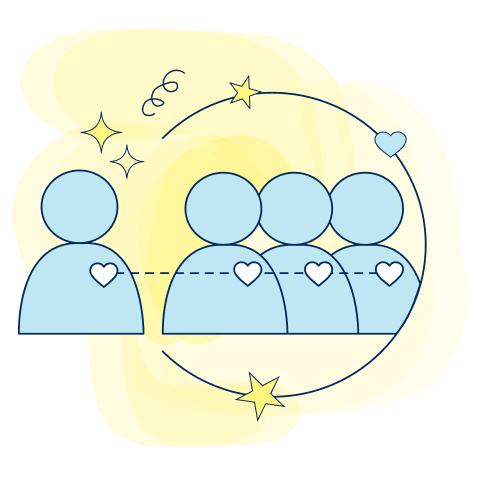Design leadership in Black-identifying communities has been incredibly influential in equity-centered design research. Ava and Lois spotlight two leaders in equity design thinking whom we continually draw inspiration from to reflect on our positionality and address complex topics with empathy, courage, and care.
Written by Ava Hawkins, Blog Editor & Digital Content Writer, Honours Bachelor of Science, Cognitive Science & Psychology & Lois Lee, Blog Digital Editor & Digital Content Writer, Master of Information, User Experience Design and Archives & Records Management
Drawing Inspiration from Black Leaders in Design Thinking
In honour of Black History Month, the Innovation Hub would like to take the time to celebrate leaders in Black-identifying communities who have directly inspired our work and continue to make significant contributions to the field of design thinking. We would like to highlight Antionette Caroll and Victor Cary, two leaders who are empowering Black-identifying designers. These leaders have also inspired us to reflect on human-centered approaches that recognize equity-deserving communities by bringing in the stories, histories, and experiences of the people we design with and for.
Creating Spaces of Belonging
Through my explorations in equity-centred design thinking, I want to highlight Victor Cary, a leader and designer most known for his work in the National Equity Project, an organization that focuses on coaching and leadership models and improving experiences of racialized students. As a lifelong learner and educator of more than 40 years, Cary applies his learning inside the classroom and beyond. For example, his graduate-level studies at Stanford University, his work with the California Alliance for Mathematics and Science Initiative, and his teaching social sciences in a secondary school.
Cary’s work at the National Equity Project has greatly impacted the equity design community and guided our current practices. We draw on Cary’s work to understand our positionality and the importance of belonging.
I originally saw “belonging” as a universal desire to feel included. I thought the feeling of belonging was a personal responsibility generated by oneself as an attitude and mindset. However, after learning more about Cary’s work through an educational video, I now understand belonging as a shared responsibility co-created by others. Belonging can be created through consideration, respect, and accessibility to help others feel seen and heard in communities, groups, and spaces. Everyone has a story to tell, and when a person or group is not included or considered in decision-making spaces, then their needs wont be met.
When multiple stories and voices are considered, we can create belonging and link multiple identities; through the teachings of design leaders such as Victor Cary, we strive to make the iHub space one where everyone feels they belong by considering multiple worldviews, needs, and experiences.
Creating with the Community
Another inspirational leader is Antionette Caroll, a social entrepreneur devoted to empowering young people in Black and Latinx communities. Caroll is the Founder and President of the Creative Reaction Lab. It was created after Caroll was living in Ferguson, Missouri, during the 2014 protests, which prompted her to invite more people to participate in local efforts and address ongoing concerns in their community. The Creative Reaction Lab began to do this by starting the Re-designers for Justice movement. This movement trains young leaders to build competencies through the Equity-Centered Community Design (ECCD) by empowering them to use their lived experiences to highlight concerns impacting themselves and the people around them and to create change.
Outside of the Creative Reaction Lab, Caroll is the co-founder, along with Timothy Bardhavens, of &Design—a mentorship program for Black, Latinx, and Indigenous designers interested in building their skills in equity-focused design initiatives. She is also the chair of a non-profit organization called the Oscar Johnson III Youth Hope Foundation. This organization was created to honour the life of her younger brother and is devoted to helping Black and Latinx youth pursue their dreams. Through her dedicated work in these organizations, Caroll reminds us that our communities are fundamentally human-centred. Therefore, we should be mindful of how we position ourselves about other people and their lived experiences, carefully listen to their stories and histories, and reflect on how we can collectively support those around us.
After learning about Antionette Caroll’s work, I was inspired by her resilience and how her community experiences motivated her to become a leader in equity design. This helped me to reflect more on the role I have in my own community. My experiences as a student, a writer, and other facets of my identity are valuable in bringing light to specific concerns. Still, I am also responsible for uplifting voices that are different from my own. I was also inspired by one of the foundational principles of The Creation Reaction Lab, which is the belief that everyone is a designer and capable of making change. I found this to be an incredibly empowering sentiment, and I strive to embody this idea in all my work.
Are you an Equity Designer or Design Ally?
After learning about human-centered approaches, along with Antionette Caroll and Victor Cary’s impactful contributions to the world of design thinking, we learned that we must actively reflect on our positionality and how we can situate ourselves as an equity designer or design ally. We must ask ourselves how we can contribute to creating spaces of belonging by considering our biases and empathizing with stories shared by other communities. What responsibilities do we hold as people who identify with the community we are working with versus people who are there to support and uplift other communities? How can our intersectional identities enable us to perform both roles in different contexts?
Many of us have wondered about these questions before and reflected on them, but the work of Antionette Caroll and Victory Cary provides us with a framework to structure these conversations. We encourage you to take these discussions further beyond simple reflection and consider new ways to act on equity allyship. Each of us has a unique power to make a difference and call on the actions of those in our networks, and that influence is often overlooked.
References
Abookire, S. (2020, July 9). “How I’m Building” with Antionette Carroll: Equity-Centered Community Design through Powershifting and Accountability. The Sustainable Future. https://medium.com/the-sustainable-future/how-im-building-with-antionette-carroll-equity-centered-community-design-through-powershifting-addf1aee067a
About Us. (n.d.). Creative Reaction Lab. Retrieved March 1, 2024, from https://crxlab.org/about-us
Antionette D. Carroll. (n.d.). https://www.antionettecarroll.design/
Lopez, G. (2016, January 27). What were the 2014 Ferguson protests about? Vox. https://www.vox.com/2015/5/31/17937764/ferguson-missouri-protests-2014-michael-brown-police-shooting
National Equity Project. (n.d.). https://www.nationalequityproject.org/
Our Approach. (n.d.). Creative Reaction Lab. Retrieved March 1, 2024, from https://crxlab.org/our-approach
Our Mission. (n.d.). &DESIGN. Retrieved March 1, 2024, from https://www.anddesign.co/about
Redesigners for Justice: The leaders we need for an equitable future. (2019, September 23). Equal Space. https://medium.com/equal-space/redesigners-for-justice-the-leaders-we-need-for-an-equitable-future-d3a73459ba60
Victor Cary – senior director at National Equity Project – LinkedIn. (n.d.). https://www.linkedin.com/in/victor-cary-66ab492b
Victor Cary. National Equity Project. (n.d.). https://www.nationalequityproject.org/team/victor-cary
Wise, S., & Cary , V. (2022, July 7). Design for belonging with Susie Wise. YouTube. https://www.youtube.com/watch?v=uSlYxIRrnF4





0 comments on “Celebrating Design Leadership in Black-Identifying Communities ”